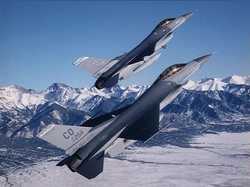Establishes Timeline Of Attack That Killed al-Qaeda Leader
 The attack that killed
Abu Musab al-Zarqawi demonstrates the flexibility that air assets
give commanders, officials in Baghdad said earlier this
week.
The attack that killed
Abu Musab al-Zarqawi demonstrates the flexibility that air assets
give commanders, officials in Baghdad said earlier this
week.
Air Force Brigadier General Stephen Hoog, an air planner with
Multinational Force Iraq, gave a timeline of the operation that
resulted in the death of the most wanted terrorist in Iraq June
7.
As Aero-News reported, an F-16 Fighting Falcon jet dropped two
precision bombs on a safe house near Baqubah, killing Zarqawi and
his spiritual adviser.
Nothing indicated this day would be different from any other for
Air Force pilots over the country, Hoog said. A flight of two F-16s
were originally conducting surveillance to detect improvised
explosive devices buried in or along highways in Iraq -- their
pilots having no idea of what was to come.
The two aircraft topped off fuel from a KC-10 air-to-air tanker,
and controllers then redirected the aircraft to support coalition
operations northeast of Baghdad, Hoog said.
"Soon after 6 pm, the flight passed the location of a safe house
where Zarqawi was hiding," he said.
At 6:11 pm, one F-16 dropped one bomb on the house and scored a
direct hit. Minutes later, the jet dropped another bomb on the same
house and again scored another direct hit, the general said. The
F-16 did not rely on people on the ground pointing a laser at the
house -- the aircraft "lased" the target from the air.
The raid was successful, ending the life and career of the
wanted terrorist in rubble.
The aircraft were the only coalition assets that could act on
the intelligence quickly, officials said. In fact, while the bombs
dropped at 6:11, the first coalition soldiers did not arrive at the
site until 6:40, and that was an 11-man military training team
embedded with a nearby Iraqi Army unit.
Officials speaking on background said it was the prudent thing
to do to spare American lives. Rumors in Baghdad said that Zarqawi
always wore a suicide vest, ready to pull the trigger if confronted
by coalition soldiers.
 "In fact, we did not
know the state of the defenses in that house," said the official.
"It would have unnecessarily put Americans at risk to send them in
when you have the aerial option like that."
"In fact, we did not
know the state of the defenses in that house," said the official.
"It would have unnecessarily put Americans at risk to send them in
when you have the aerial option like that."
Adding to the decision, officials said was the fact that the
house was isolated and chances of collateral damage was minimal.
"We could still have done it in a city, but it would have been a
much more involved decision," the official said.
The F-16s continued to fly cover over the site until relieved.
It wasn't until the next day, Hoog said, that the
still-unidentified pilot learned who was the target.
The general emphasized that the attack was a team effort.
Persistent surveillance over the battlefield comes from unmanned
aerial vehicles such as the Global Hawk and Predator. Hoog said
satellite surveillance also helped in pinpointing the precise
global positioning system coordinates for dropping the second
bomb.
(Aero-News thanks Jim Garamone, American Forces Press
Service)
 ANN's Daily Aero-Linx (04.17.24)
ANN's Daily Aero-Linx (04.17.24) ANN's Daily Aero-Term (04.17.24): Jamming
ANN's Daily Aero-Term (04.17.24): Jamming ANN's Daily Aero-Linx (04.18.24)
ANN's Daily Aero-Linx (04.18.24) Aero-News: Quote of the Day (04.18.24)
Aero-News: Quote of the Day (04.18.24) ANN's Daily Aero-Term (04.18.24): Hold-In-Lieu Of Procedure Turn
ANN's Daily Aero-Term (04.18.24): Hold-In-Lieu Of Procedure Turn




